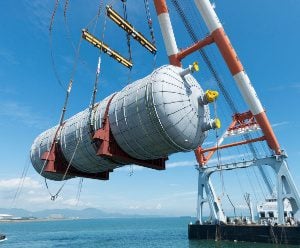
Harnessing renewable energy with solar and wind for sustainable logistics

2023 marked a booming year for clean energy, with 50 percent more renewables capacity added to energy systems around the world compared to the previous year. The end of 2023 saw the 28th Conference of the Parties of the UNFCC (United Nations Framework Convention on Climate Change), also known as COP28, calling to triple renewable energy capacity by 2030.
Driven by growing demand, countries are now answering this call with sustainability roadmaps of their own. According to the International Energy Agency’s (IEA) Renewables 2023 report, additional renewable electricity capacity reached 507 gigawatts (GW) in 2023, with solar PV making up three-quarters of global additions. The increasing momentum to decarbonize could lead to the fastest growth in renewable energy in the next five years.
Renewable energy projects are the talk of the town, measures bring nations and companies closer to their net zero carbon goals, leading to long-term energy cost savings. But implementing them comes with its own set of challenges, with significant hurdles in the journey toward a carbon-neutral future.
Pooling power to finance the future
High upfront capital expenditure for renewable energy projects often deters companies or countries from adopting renewable energy. Securing funding involves navigating complex financial markets, obtaining favorable loan terms, and ensuring reliable returns on investment (ROI).
Additionally, volatile energy prices and policy uncertainties impact financial planning.
To address these challenges, companies are exploring innovative financing methods like green bonds, which fund sustainable projects public-private partnerships (PPAs) to sustain the growth of renewable energy.
One such example is the Corporate Renewable Energy Aggregation Group (CREAG) initiative, which brought together five global companies to collectively purchase renewable energy from a single wind farm. PPAs like this reduce individual financial risk while helping companies achieve greater economies of scale.
Before such agreements, smaller companies struggled to secure agreements with renewable projects, often having to wait for larger companies to buy the bulk of the output first before being allowed to purchase the leftover power. By pooling resources and demand, CREAG facilitated better financing terms and lowered procurement costs.
Countries like India and Indonesia have also experienced specific financial challenges due to currency volatility and fluctuating interest rates, negatively affecting project costs and financing terms. In Indonesia, securing investments in renewable projects can be difficult due to perceived political and regulatory risks.
Thus, global lenders are stepping in to contribute to Indonesia's decarbonization goals, pledging US$20 billion in financing. Under the Just Energy Transition Partnership (JETP), Indonesia aims to reduce carbon dioxide emissions for its on-grid power systems to 250 million metric tonnes from its current 350 million metric tonnes.
For similar reasons, renewable energy developers in India often experience high-interest rates and limited access to low-cost financing.
In response, the Indian government has introduced various financial incentives, such as tax benefits and subsidies. International financial institutions and development banks are also collaborating to provide financing options. India’s 400-megawatt hybrid renewable energy project, which combines three wind farms, one solar farm, and battery storage aims to provide consistent, round-the-clock power. Made possible through a 5-year term loan of US$1 billion, the project was facilitated by an international hedging bank coordinating with other financial institutions to secure the necessary funds and manage potential financial risks.
Land, leases, and logistics
Renewable energy projects also require considerable land resources. Utility-scale solar photovoltaic (PV) projects need 3 to 5 acres per megawatt, while onshore wind farms cover several square kilometers. While the land can be repurposed for other agricultural purposes, geographical and meteorological analyses are necessary to optimize energy outputs.
In regions like Western Australia's Pilbara, companies must navigate land tenure issues and balance environmental conservation with agricultural interests and community needs.
The best decisions are made after thoroughly assessing factors such as solar irradiance, wind resources, and environmental impact. Companies leverage advanced Geographic Information System (GIS) technology and conduct comprehensive stakeholder consultations to identify mutually beneficial and time-efficient solutions.
Acquiring the equipment for these renewable energy projects also involves some logistical challenges, from supply chain disruptions to procurement complexities. Fluctuations in market prices, coupled with concerns over quality assurance and lead time variability, impose significant strains on project timelines and budgets.
Companies are thus diversifying their supplier base and exploring localized manufacturing options to reduce dependency on a singular country for their materials or equipment. This allows their supply chains to remain agile when challenges such as supply chain bottlenecks and raw material shortages occur, impacting project schedules and expenditures. Resilience planning, and collaboration with industry counterparts play a crucial part in procurement strategies to ensure a dependable and cost-efficient flow of components.
DHL Group secures green electricity from EnBW's offshore wind farm
DHL Group secures green electricity from EnBW's offshore wind farm
DHL Group has agreed to a long-term electricity supply contract with ENBW Energie Baden-Württemberg AG for the purchase of around 80 gigawatt-hours per year of electricity from renewable sources from 2026, taking another step toward its own decarbonization targets. The electricity will be produced in the He Dreiht offshore wind farm in the German North Sea, which is scheduled to go into operation in stages until spring 2026. The Power Purchase Agreement (PPA) between DHL Group and EnBW is set for ten years. With the energy from He Dreiht, the company covers approximately 16 percent of its current annual electricity demand in Germany.
Wired for change
Operationally, companies also face the technical challenge of integrating renewable energy into existing grid infrastructure. The intermittency of solar and wind power requires dependable and efficient grid management systems to ensure a stable electricity supply. Substantial upgrades are often necessary to existing grid infrastructure to optimize increased energy load and ensure efficient distribution.
Companies are directing investments toward smart grid technologies, energy storage solutions, and grid modernization endeavors to address these challenges. The Australian Energy Market Operator (AEMO) spearheads initiatives like the Renewable Integration Study for the evolution of the National Electricity Market (NEM) reform, amidst the exponential growth of renewable energy within the nation. Grid flexibility and reliability are enhanced, along with the forecasting and dispatch of renewable energy.
Similarly, in Japan, implementing the Feed-in Tariff (FIT) scheme has led directly to a surge in renewable energy projects, increasing tenfold from 5 million kilowatts in the fiscal year 2011 to 63.5 million kilowatts in the 2021 fiscal year. This has necessitated essential upgrades to the grid infrastructure. Investments in smart grid technologies, including advanced metering infrastructure (AMI) and demand response systems, play a crucial role in integrating renewable energy while preserving grid stability.
Heavy lifting
Safely and efficiently transporting bulky components like solar panels, wind turbines, and tower sections requires specialized transportation methods and equipment. However, inadequate infrastructure, road restrictions, and regulatory barriers can further complicate transportation efforts.
To surmount these obstacles, companies prioritize investments in fleet optimization, forging partnerships with logistics providers, and advocating for infrastructure enhancements. In Australia, transporting renewable energy equipment to remote project sites in the rugged terrain of the Pilbara region underscores challenges like road accessibility and adverse weather conditions. Implementing specialized transportation methods and contingency plans becomes imperative to ensure the safe and timely delivery of equipment.
Different countries and markets also have specific requirements that need to be satisfied. Indonesia's archipelagic landscape necessitates a strong maritime logistics network to ferry renewable energy equipment to its remote islands.
With a growing emphasis on off-grid solutions and island electrification projects, the nation and its companies must navigate logistical complexities such as port operations, customs clearance, and vessel scheduling, to expedite and streamline the transition to renewable energy sources. Dependable logistics solutions, such as leveraging advanced route planning software and collaborating with local authorities to adhere to transportation regulations are essential to optimizing supply chain efficiency and minimizing disruptions.
Energizing minds
The implementation and constant improvement of renewable energy systems will depend on a skilled workforce proficient in managing and operating advanced energy technologies. Therefore, it is crucial to close the skill gaps and workforce shortages within the sector which may deter operational efficiency.
China, for instance, has made significant investments in workforce development, as part of their steadfast commitment to renewable energy. Establishing specialized training centers and educational programs dedicated to renewable energy technologies has played a pivotal role in developing the nation’s skilled workforce. Partnerships forged between universities and renewable energy firms have also facilitated research and development endeavors, fostering the exchange of knowledge and expertise critical for meeting the nation's ambitious renewable energy target of 1200 gigawatts by 2030.
Similarly, in India, the establishment of the Skill Council for Green Jobs has been pivotal in bridging skill gaps among employees within the renewable energy sector. By developing standardized training modules and certification programs, workers accumulate the competencies essential for various roles across the renewable energy value chain.
Singapore’s SkillsFuture credit also offers courses on renewable energy adoption and smart grids, among other topics, ensuring that skillsets are upgraded and kept relevant with fresh technological developments. Collaborations with international bodies ensure that these training programs align with global standards and best practices, further enhancing the workforce's readiness to tackle the evolving demands of the renewable energy industry.
ALSO WORTH READING
















 English
English